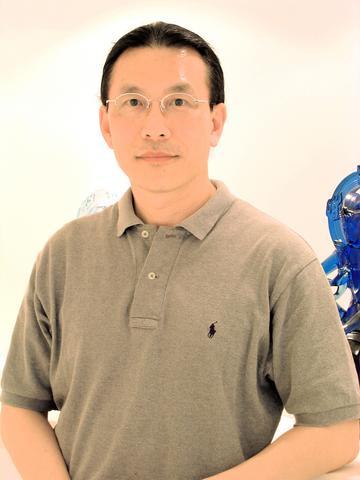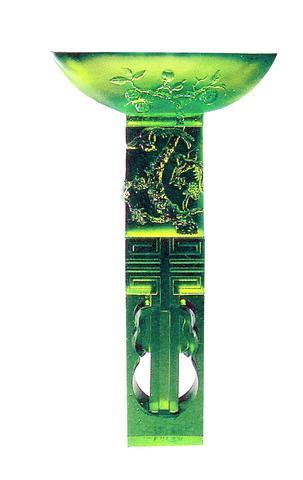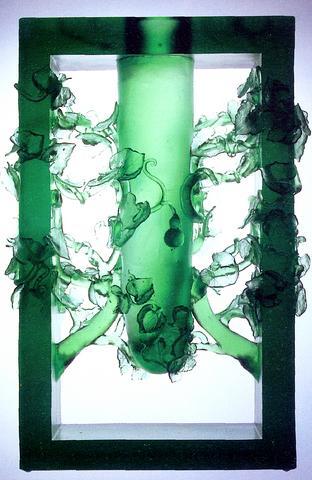Depending on who you ask, credit for the invention of glass can either be given to the Romans, the Chinese or the Mesopotamians. According to one rather suspect legend, a group of Roman sailors invented the substance whilst cooking a meal on a beach one evening. And then of course, there's the eastern tale of how, over 2,000 years ago a group of erstwhile Chinese entrepreneurs inadvertently stumbled across the secret of glass.
A more accurate account, however, places the beginning of glass production roughly 2,500 years prior to either of these events and credits Mesopotamian potters with the invention.
Disregarding the question of whose hand the substance we now all take for granted first came into being, there is little doubt as to the name of the chap who has managed to etch Taiwan's name on the international glassware map.

PHOTO: GAVIN PHIPPS,TAIPEI TIMES
Heinrich Wang (王俠軍) of Tittot (琉園) has built up a thriving business that has influenced artists and university art facilities all over the world, with the simple combination of sand, soda, lime and, of course, a whole lot of heat. All of which was made possible with a seven month course in glass blowing, cutting and grinding.
"I worked in the local movie industry for a bit and made a few fiction movies. But then simply got fed up with it and figured it was time for a change," Wang said. "I certainly didn't plan to, or have any illusions about becoming so successful."
Putting his clapperboard away in 1987, Wang enrolled at the Center for Creative Studies at the Detroit College of Art and Design. There he spent seven months studying every aspect of working with glass. On his return to Taiwan in 1988, Wang rented a disused workshop in Tamsui, calling it Liuli Gong Fang (琉璃工房).

It was good timing. The late 1980s was the beginning of the end for Hsinchu's once thriving glassware industry. "For many years Hsinchu was to glass work what Yingko is to pottery and Sanyi is to woodcarving -- a center of excellence," the pony-tailed artist said. "About 15 years ago, though, the factories started to close down. The predominantly export-orientated businesses moved to China because of lower running costs and cheaper labor."
Along with teaching seven close artist friends the skills he'd learnt, Wang set about developing his own glass art production techniques at the Liuli studio.
"As local artists steered clear of using glass as a medium at that time, very few people were aware of the extensive possibilities it offered," Wang said. "Which meant I had to do more than simply teach the hows and whys of working with glass. I had to cover everything, even glass appreciation."

Wang used Western methods combined with traditional Asian aspects and, most importantly for the artist, a truly contemporary Taiwanese flavor. After two years and countless experiments, Wang decided to hold his first exhibition. Held at a popular local bookstore, it was an immediate success.
Wang said his days as a face in the local movie industry enabled him to drum up some media interest, while the pricing of his works virtually guaranteed him an instant following amongst art lovers and the general public alike.
"I was well aware that I needed to make a splash if glass artwork was ever going to catch on," Wang said. "Obviously, getting media attention was easy, but I also decided to put the price tag of NT$1 on every piece."
Whether they knew it or not, those lucky enough to have purchased one of Wang's early works certainly got a bargain. His work now commands prices of between a couple of thousand and several hundred thousand New Taiwan Dollars. Several of his works have pride of place in museums in the US, Europe as well as Taiwan. He is also the only Taiwanese artist whose glass works are part of the permanent collection at Beijing's National Place Museum (
Leaving the Liuli workshop in 1993, Wang set about creating a more commercial name for both himself and his art. A year later he founded the Titto Company. Now there are 21 stores in Taiwan and 20 international stores ranging from Hong Kong, Singapore, Japan, the US, Italy and Saudi Arabia.
In addition to over-the-counter sales, Wang and Titto have built up a solid reputation for custom-made corporate works. Global organizations that have commissioned Wang to create original pieces include Jaguar, Mercedes-Benz, Cathay Group, Swatch and Acer.
Branching out from the world of business in 1999, Wang founded the Tittot Glass Art Museum (
Instead of simply teaching professional artists the tricks of the trade, Wang has set out to teach not only just how easy the creation of glass artwork can be, but also the history and social importance of the age-old art form.
"Historically, glass has been an important part of Chinese culture dating back at least 2,000 years, but there was nowhere where this was explained in Taiwan," Wang said. "In Austria, the Czech Republic and Italy, where glass is a celebrated art form, there are numerous museums that show it. So I simply decided it was time Taiwan had one as well." The museum now attracts around 4,000 visitors on any given month.
To cap his decade in glass art, last year Wang's work and the Titto brand name became the first Chinese and sole Taiwanese crystal glass brand to be acknowledged by Messe Frankfurt -- a major player in the business.
"It was a great honor for me, the company and of course Taiwan to be recognized [by Messe Frankfurt]. It has enabled us to be a truly global player," Wang said. "It means that we now command the same international standing and can compete with such celebrated glassware brands as Waterford, Baccarat and Daum."
Though the day to day operations of his business now consume much of Wang's time, the ever-cordial glass entrepreneur still adamantly refuses to be labeled a businessman.
"Its more difficult to create works for a wider market than for oneself. You have to think of others and find a niche rather than simply acting on your own," he explained.
"The way I look at how I develop my works has certainly changed, but my overall line of thought vis-a-vis what is art remains the same. And, yes, I'm still an artist."
The Tittot Glass Art Museum (琉園水晶博物館) is located at 16, Lane 515, Chungyang N Rd, Sec 4, Peitou District, Taipei (台北市北投區中央北路四段515巷16號). The museum is open from 9am until 5pm Tuesdays through Sundays. For information about and enrollment dates for the museum's upcoming glass blowing, etching and molding classes call (02) 2895 8861 or log on to www.glass.com.tw/en/index-museum.htm.

This is the year that the demographic crisis will begin to impact people’s lives. This will create pressures on treatment and hiring of foreigners. Regardless of whatever technological breakthroughs happen, the real value will come from digesting and productively applying existing technologies in new and creative ways. INTRODUCING BASIC SERVICES BREAKDOWNS At some point soon, we will begin to witness a breakdown in basic services. Initially, it will be limited and sporadic, but the frequency and newsworthiness of the incidents will only continue to accelerate dramatically in the coming years. Here in central Taiwan, many basic services are severely understaffed, and

Jan. 5 to Jan. 11 Of the more than 3,000km of sugar railway that once criss-crossed central and southern Taiwan, just 16.1km remain in operation today. By the time Dafydd Fell began photographing the network in earnest in 1994, it was already well past its heyday. The system had been significantly cut back, leaving behind abandoned stations, rusting rolling stock and crumbling facilities. This reduction continued during the five years of his documentation, adding urgency to his task. As passenger services had already ceased by then, Fell had to wait for the sugarcane harvest season each year, which typically ran from

It is a soulful folk song, filled with feeling and history: A love-stricken young man tells God about his hopes and dreams of happiness. Generations of Uighurs, the Turkic ethnic minority in China’s Xinjiang region, have played it at parties and weddings. But today, if they download it, play it or share it online, they risk ending up in prison. Besh pede, a popular Uighur folk ballad, is among dozens of Uighur-language songs that have been deemed “problematic” by Xinjiang authorities, according to a recording of a meeting held by police and other local officials in the historic city of Kashgar in

The People’s Republic of China (PRC) was out in force in the Taiwan Strait this week, threatening Taiwan with live-fire exercises, aircraft incursions and tedious claims to ownership. The reaction to the PRC’s blockade and decapitation strike exercises offer numerous lessons, if only we are willing to be taught. Reading the commentary on PRC behavior is like reading Bible interpretation across a range of Christian denominations: the text is recast to mean what the interpreter wants it to mean. Many PRC believers contended that the drills, obviously scheduled in advance, were aimed at the recent arms offer to Taiwan by the